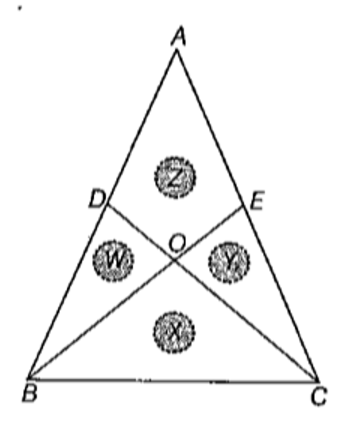An isosceles right traingle ABC with BC = AC slides on the axes with A and B on x and y axes respectively. The locus of C is …………… .
The correct Answer is:x - y = 0
To find the locus of point C in the isosceles right triangle ABC, where A is on the x-axis, B is on the y-axis, and BC = AC, we can follow these steps:
Step 1: Set Up the Coordinates
Let the coordinates of points A and B be:
- A = (h, 0) on the x-axis
- B = (0, k) on the y-axis
Since C is the right angle vertex of the triangle, its coordinates can be represented as C = (h, k).
Step 2: Use the Isosceles Right Triangle Property
In an isosceles right triangle, the lengths of the two legs (BC and AC) are equal. Therefore, we have:
- Length of AC = Length of BC
Using the distance formula, we can express these lengths:
- AC = √((h - 0)² + (k - 0)²) = √(h² + k²)
- BC = √((h - h)² + (k - 0)²) = √(k²)
Since AC = BC, we can set these equal:
√h2+k2=√k2
Step 3: Square Both Sides
Squaring both sides to eliminate the square roots gives:
h2+k2=k2
Step 4: Simplify the Equation
Subtract k2 from both sides:
h2=0
Step 5: Interpret the Result
This implies that h=0. However, we need to consider the movement of point C as A and B slide along the axes.
Step 6: Generalize the Locus
Since A can be at any point (h, 0) and B can be at any point (0, k), we can express the relationship between x and y coordinates of point C:
- From the triangle properties, we know that:
- C lies on the line y=x (since both legs are equal and the triangle is isosceles).
- C also lies on the line y=−x (the reflection across the origin).
Conclusion
Thus, the locus of point C as the triangle slides along the axes is given by the equations:
y=xandy=−x
Let the coordinates of points A and B be:
- A = (h, 0) on the x-axis
- B = (0, k) on the y-axis
In an isosceles right triangle, the lengths of the two legs (BC and AC) are equal. Therefore, we have:
- Length of AC = Length of BC
- AC = √((h - 0)² + (k - 0)²) = √(h² + k²)
- BC = √((h - h)² + (k - 0)²) = √(k²)
√h2+k2=√k2
Squaring both sides to eliminate the square roots gives:
h2+k2=k2
Subtract k2 from both sides:
h2=0
This implies that h=0. However, we need to consider the movement of point C as A and B slide along the axes.
Since A can be at any point (h, 0) and B can be at any point (0, k), we can express the relationship between x and y coordinates of point C:
- From the triangle properties, we know that:
- C lies on the line y=x (since both legs are equal and the triangle is isosceles).
- C also lies on the line y=−x (the reflection across the origin).
Thus, the locus of point C as the triangle slides along the axes is given by the equations:
y=xandy=−x
Topper's Solved these Questions
- BOOK - FIITJEECHAPTER - STRAIGHT LINE EXERCISE - ASSIGNMENT PROBLEMS (SUBJECTIVE) Level - II14videos
STRAIGHT LINE
- BOOK - FIITJEECHAPTER - STRAIGHT LINE EXERCISE - ASSIGNMENT PROBLEMS (OBJECTIVE) Level - I50videos
STRAIGHT LINE
- BOOK - FIITJEECHAPTER - STRAIGHT LINE EXERCISE - ASSIGNMENT PROBLEMS (SUBJECTIVE) Level - I9videos
STRAIGHT LINE
- BOOK - FIITJEECHAPTER - STATISTICSEXERCISE - Comprehension Type6videos
STATISTICS
- BOOK - FIITJEECHAPTER - TEST PAPERSEXERCISE - MATHEMATICS328videos
TEST PAPERS
Similar Questions
Triangle ABC with AB=13,BC=5, and AC=12 slides on the coordinates axes with AandB on the positive x-axis and positive y-axis respectively. The locus of vertex C is a line 12x−ky=0. Then the value of k is_____________
View SolutionA straight line of length 9 units slides with ends A, B always on x and y axes respectiv Locus of centroid of AOAB is
View SolutionThe incircle of an isosceles triangle ABC, with AB=AC, touches the sides AB, BC, CA at D,E and F respectively. Prove that E bisects BC.
View SolutionA straight rod of length 3l units slides with its ends A,B always on the x and y axes respectively,then the locus of the centriod of ΔOAB is
View SolutionA straight line of length 3 units slides with its ends A,B always on X and Y axes respectively.If locus of centroid of ΔOAB is ax2+by2=c then a+b+c=
View SolutionIn an isosceles triangle ABC, the coordinates of the points Band C on the base BC are respectively (1,2) and (2.1). If the equation of the line AB is y=2x, then the equation of the line AC is
View SolutionIn an isosceles triangle ABC with AB=AC, a circle passing through B and C intersects the sides AB and AC at D and E respectively. Prove that DEBC
View SolutionIn an isosceles triangle ABC with AB=AC, a circle passing through B and C intersects the sides ABandAC atDandE respectively. Prove that DECB.
View SolutionA right angled triangle ABC having a right angle at C, CA=b and CB=a, move such that h angular points A and B slide along x-axis and y-axis respectively. Find the locus of C
View SolutionIn an isosceles triangle ABC, side BC is distinct from rest of the sides. CD and BE are the medians on AB and AC, respectively. If W,X,Y and Z represents distinct areas in the triangle, find the ratio of W:X:Y:Z
 View Solution
View Solution

